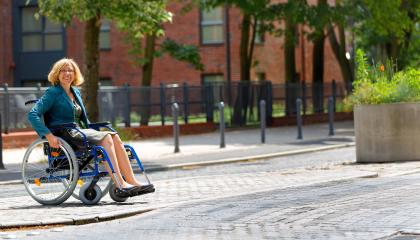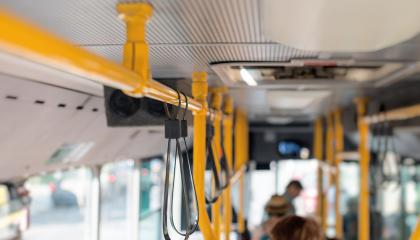For the urban setting, bike lanes can offer many benefits to the community. More and more cities are seeking ways to cut down on congestion while also improving the environment, and these cities are turning to the bicycle. However, the addition of e-bikes and shared bicycles is creating its own number of problems.
A protected bicycle sidewalk is a pathway designated specifically for bikes, usually marked with signs, curbs, or posts to separate the bicycle lane from automobile traffic on the street. Bike-friendly routes create an urban environment that makes biking not only practical but safer too. A protected bicycle lane can cut down on commuter congestion and city pollution.
Private accessible transportation refers to transportation that caters to individuals with impairments. While not necessarily in the public sector, private transportation includes volunteer driver programs, para-transit services, and ride-shares which must comply with the Americans with Disabilities Act (ADA).
Forming ideas about how other people live is a common problem, and individuals who live with a disability often face a number of myths about disabilities. These misconceptions come from a variety of places, whether through stereotypes or misinformation. Many disability myths are rooted in a misunderstanding about what it’s like to live with a disability.
To help diminish the ongoing stigma, stereotypes, and myths that people with disabilities face, it’s crucial that society does work to debunk common disability myths.
Since 1990, pedestrian fatalities have increased, and for pedestrians with disabilities, the risk is even higher. From 2007 to 2017, pedestrian deaths increased by 35%. When researchers studied the cities with the highest fatalities, they came across sidewalks in disrepair, lacking curb ramps, and poorly designed crosswalks.
While we have more work to be done to set up a protective infrastructure for pedestrians, there are a few simple driving techniques that will keep others safe.
Public transportation offers independence to individuals with low vision, providing opportunities for community involvement, job commute, and so much more. While public transportation offers independence, it can be difficult for individuals with low vision to navigate the transportation system. Any public transportation can be complicated to use--from finding the right route, boarding the correct bus, and exiting at the right stop.
Interior home accommodations for individuals with disabilities can create a more welcoming and accessible living experience for friends, family, and visitors who deal with disabilities. Depending on whether or not you have someone who needs the accommodations daily or if you have the occasional visitor with disabilities, these interior home accommodations can make a big difference.
Mainstream transportation infrastructure and public services are predominantly designed for individuals who do not use mobility devices to navigate life. As tech companies connect transportation to apps, the services still target individuals without mobility issues or mobility devices. While this is not a bad thing, cheaper and smarter transportation options should also be factored in for individuals with disabilities.
Approximately ten percent of the world’s population lives within 32 feet of sea level, and while a large percentage lives at higher elevations, most still live close to coastlines. As temperatures rise, scientists have noted an increase in coastal flooding, which presents a safety hazard to the population of coastal cities, businesses, and profit.
Studies have revealed that the rate of sea-level rise has increased substantially in the last 2,800 years. In fact, sea levels have risen almost 3 inches in the last twenty years.
While the Americans with Disabilities Act (ADA) outlines a set of standards for accommodating the needs of individuals with disabilities, ADA compliance is something that benefits everyone. When our businesses, neighborhoods, and local government agencies work to be considerate of individuals with differing needs, our inclusive community provides the space to recognize the unique gifts and perspectives that these individuals can offer.
Pagination
Connect with us
We pride ourselves on our customer service, and we'd love to hear from you! Sign up for our newsletter to keep up with industry updates and trends, as well as any new product releases.












